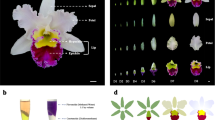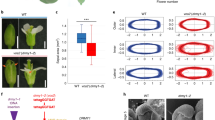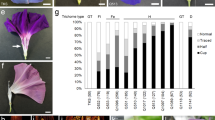Abstract
FLOWERcolour is determined primarily by the production of pigments, usually anthocyanins or carotenoids, but the shade and intensity of the colour are often changed by other factors such as vacuolar compounds, pH and metal ions1, 2. Pigmentation can also be affected by the shape of epidermal cells, especially those facing prospective pollinators3,4. A conical shape is believed to increase the proportion of incident light that enters the epidermal cells, enhancing light absorption by the floral pigments, and thus the intensity of their colour. We have identified a gene (mixta) that affects the intensity of pigmentation of epidermal cells in Antirrhinum majuspetals. The cells of the corolla lobes fail to differentiate into their normal conical form in mixta mutants. We have cloned the mixta gene by transposon tagging; its sequence reveals that it encodes a Myb-related protein that probably participates in the transcriptional control of epidermal cell shape.
This is a preview of subscription content, access via your institution
Access options
Subscribe to this journal
Receive 51 print issues and online access
$199.00 per year
only $3.90 per issue
Buy this article
- Purchase on Springer Link
- Instant access to full article PDF
Prices may be subject to local taxes which are calculated during checkout
Similar content being viewed by others
References
Brouillard, R. The Flavonoids (ed. Harbourne, J. B.) 525–538 (Chapman Hall, London, 1988).
Chuck, G. et al. Plant Cell 5, 371–378 (1993).
Kay, Q. O. N., Daoud, H. S. & Stirton, C. H. Bot. J. Linn. Soc. 83, 57–84 (1981).
Kay, Q. Plants Today July-August issue, 109–114 (1988).
Stubbe, H. Genetik und Zytologie von Antirrhinum L sect. Antirrhinum (VEB Gustav Fischer, Jena, 1966).
Luo, D., Caen, E. S., Doyle, S. & Carpenter, R. Plant J. 1, 59–69 (1991).
Avila, J., Nieto, C., Canas, L., Benito, M. J. & Paz-Ares, J. Plant J. 3, 553–562 (1993).
Jackson, D., Culianez-Macia, F., Prescott, A., Roberts, K. & Martin, C. Plant Cell, 3, 115–125 (1991).
Goff, S. A., Cone, K. C. & Fromm, M. E. Genes Dev. 5, 298–309 (1991).
Paz-Ares, J., Ghosal, D., Wienand, V., Peterson, P. A. & Saedler, H. EMBO J., 6, 3553–3558 (1987).
Grotewold, E., Athma, P. & Peterson, T. Proc. natn. Acad. Sci. U.S.A. 88, 4587–4591 (1991).
Oppenheimer, D. G., Herman, P. L., Sivakumaran, S., Esch, J. & Marks, M. D. Cell 67, 483–493 (1991).
Marks, M. D. & Feldmann, K. A. Plant Cell 1, 1043–1050 (1989).
Hülskamp, M., Miséra, S. & Jürgens, G. Cell 76, 555–565 (1994).
Kevan, P. G. & Lane, M. A. Proc. natn. Acad. Sci. U.S.A. 82, 4750–4752 (1985).
Sommer, H. et al. EMBO J. 9, 605–613 (1990).
Martin, C., Carpenter, R., Sommer, H., Saedler, H. & Caen, E. S. EMBO J. 4, 1625–1630 (1985).
Lassner, M. W., Peterson, P. & Yoder, J. I. Plant molec. Biol. Rep. 7, 116–128 (1989).
Smith, A. M. & Woolhouse, H. W. Planta 159, 570–578 (1983).
Plaskitt, K. A. et al. Molec. Plant Microbe Interact. 1, 10–16 (1988).
Coen, E. S., Carpenter, R. & Martin, C. Cell 47, 285–296 (1986).
Author information
Authors and Affiliations
Rights and permissions
About this article
Cite this article
Noda, Ki., Glover, B., Linstead, P. et al. Flower colour intensity depends on specialized cell shape controlled by a Myb-related transcription factor. Nature 369, 661–664 (1994). https://doi.org/10.1038/369661a0
Received:
Accepted:
Issue Date:
DOI: https://doi.org/10.1038/369661a0
This article is cited by
-
Molecular mechanisms regulating ornamental traits and scent production in snapdragon (Antirrhinum majus L.)
Horticulture Advances (2023)
-
Characterisation of the Mentha canadensis R2R3-MYB transcription factor gene McMIXTA and its involvement in peltate glandular trichome development
BMC Plant Biology (2022)
-
GsMYB7 encoding a R2R3-type MYB transcription factor enhances the tolerance to aluminum stress in soybean (Glycine max L.)
BMC Genomics (2022)
-
The R2R3-MYB gene CgMYB4 is involved in the regulation of cell differentiation and fiber development in the stamens of Chelone glabra L.
Protoplasma (2022)
-
Genome-Wide Mining of MYB Transcription Factors in the Anthocyanin Biosynthesis Pathway of Gossypium Hirsutum
Biochemical Genetics (2021)
Comments
By submitting a comment you agree to abide by our Terms and Community Guidelines. If you find something abusive or that does not comply with our terms or guidelines please flag it as inappropriate.



